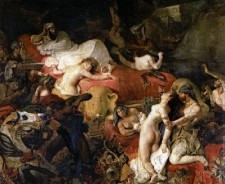
Eugène Delacroix
1841 ca., 1798-1863
Christ on the Sea of Galilee, 1841
Oil on canvas
18 x 21 1/2"
The Nelson-Atkins Museum of Art, Kansas City, Missouri. Purchase: William Rockhill Nelson Trust, through exchange of the gifts of the Friends of Art, Mr. and Mrs. Gerald Parker, and Durand-Ruel Galleries; and the bequest of John K. Havemeyer
89-16

Death of Sardanapalus, 1827, Musée du Louvre, Paris
COMMENTS
With regard to chronology, the four authentic versions with a rowing-boat show a logical development: the Portland version is clearly the closest in detail and execution to the oil sketch formerly in the Hafter-Reinhart collection, which can be assumed to initiate the series. The Nathan version marks a considerable refinement on the Portland version, both in subtlety of handling and variegation of costume. The curiously naked buttocks of the foremost oarsman are draped, the female-looking disciple in the bow is replaced by a grey-beard. Assuming that it is the version that belonged to Grzymala on the grounds stated, it was painted between April and June 1853. Last comes the Metropolitan Museum version which, though extremely close to the Nathan version in almost every respect, nevertheless seems to develop the logical sequence by not only retaining the old man in the bow, but also changing the effeminate figure with arm over head into a bearded one.
The versions with rowing-boat mark a resolution of the spatial disunity of the “Death of Sardanapalus.” Delacroix retains the Baroque diagonal of the earlier picture, the helmsman in similar pose corresponding to "Sardanapalus," but counteracts its recession by tilting the whole composition (not merely the foreground as in the earlier painting) into an almost vertical plane, and by placing limbs, oars, and draperies parallel to the picture plane along the entire length of the diagonal. He thus preserves some of the spatial tensions of the “Sardanapalus” but resolves them by integrating them more fully into a dynamic unity.
Van Gogh referred to the version now in the Metropolitan Museum, New York, on several occasions at a critical period of his development at Arles, when, inspired by Delacroix, he was seeking a more emotive and symbolic use of color in reaction against Impressionism. He wrote to Theo saying the picture "speaks a symbolic language through color alone." Slightly later, in the same letter where he makes the famous remark about his “Night Café,” "I have tried to express the terrible passions of humanity by means of red and green," he quotes with evident approval, if slightly inaccurately, Paul Mantz’s comment on the Delacroix: "I did not know that one could be so terrible with a little blue and green." Delacroix’s picture also seems relevant to Van Gogh’s new color experiments in the “Portrait of Bach,” where Vincent aspired "to paint men and women with that something of the eternal which the halo used to symbolize, and which we seek to convey by the actual radiance and vibration of our coloring," and where, he wrote, by the "simple combination of the bright head [containing much citron yellow] against the rich blue background, I get a mysterious effect, like a star set in the deep azure." Compare: "Delacroix paints a Christ by means of the unexpected effect of a bright citron-yellow note [for the halo] which possesses the same unspeakable strangeness and charm in the picture as a star in a corner of the firmament."
- Lee Johnson, The Paintings of Eugène Delacroix, A Critical Catalog, v. III, Oxford, Clarendon Press, 1986, pp. 232-5
SBMA CURATORIAL LABELS
This theme was one of the most popular produced by Delacroix and his studio and exists in more than a dozen versions. The story is intended to underscore the importance of Christian faith, even in the face of seeming doom: Christ sleeps unperturbed, while his disciples rise up in alarm at the impending storm. When they awake him, he miraculously calms the seas and asks "Where is your faith?"
This painting was categorized, we think inaccurately, as a preparatory sketch when it was sold in the artist‘s estate sale in 1864. Rather it is a relatively late work, probably done in the 1850s, when Delacroix developed an even looser, more spontaneous brushwork and an audacious use of complementary hues. Rapidly applied pigment expertly captures the sensation of wind-blown movement, while areas of vivid red and green or blue and orange generate a dynamic tension that contrasts expressively with the cool stillness of Christ‘s periwinkle blue robe.
- Delacroix and the Matter of Finish, 2013
